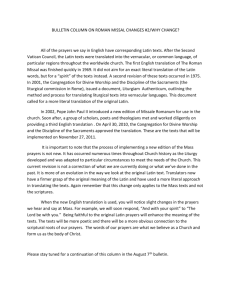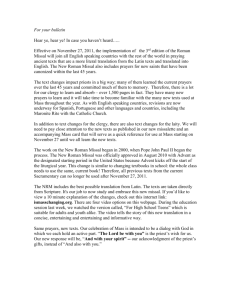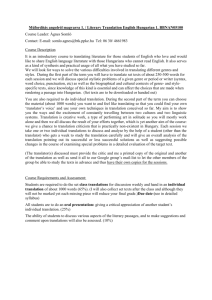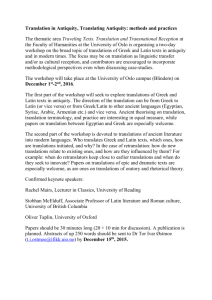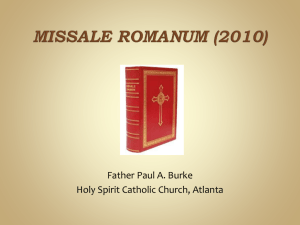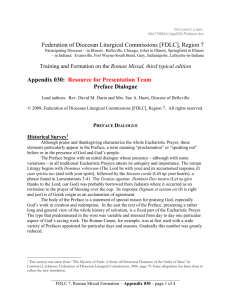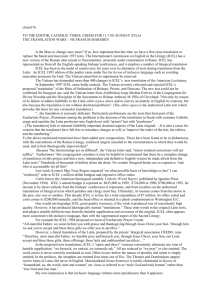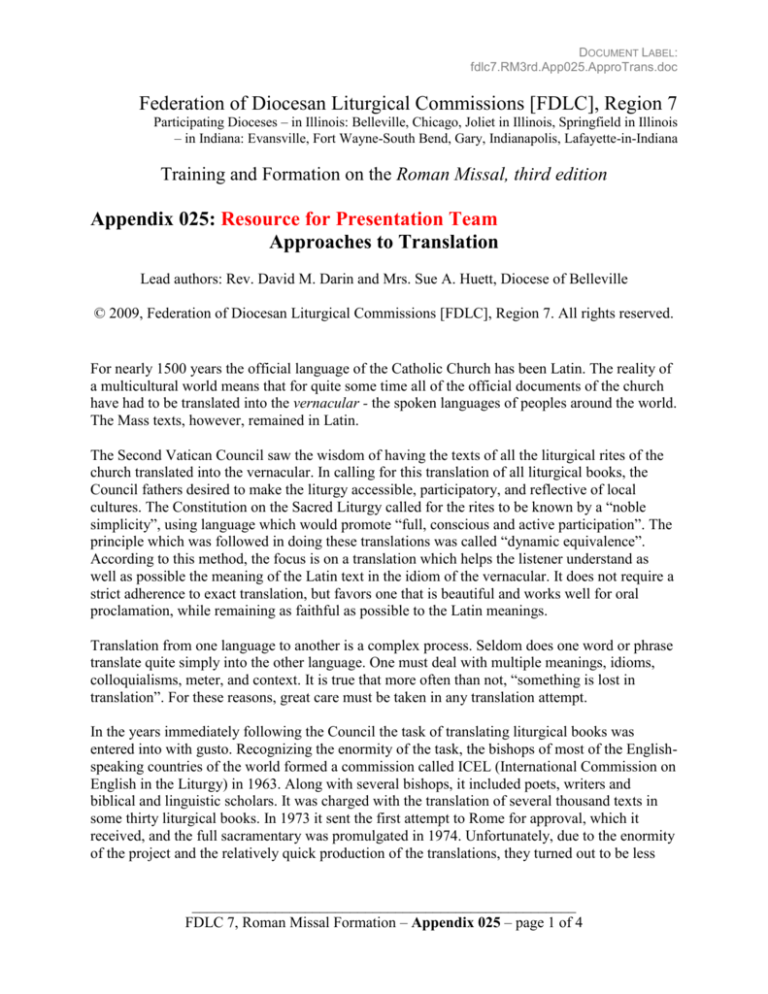
DOCUMENT LABEL:
fdlc7.RM3rd.App025.ApproTrans.doc
Federation of Diocesan Liturgical Commissions [FDLC], Region 7
Participating Dioceses – in Illinois: Belleville, Chicago, Joliet in Illinois, Springfield in Illinois
– in Indiana: Evansville, Fort Wayne-South Bend, Gary, Indianapolis, Lafayette-in-Indiana
Training and Formation on the Roman Missal, third edition
Appendix 025: Resource for Presentation Team
Approaches to Translation
Lead authors: Rev. David M. Darin and Mrs. Sue A. Huett, Diocese of Belleville
© 2009, Federation of Diocesan Liturgical Commissions [FDLC], Region 7. All rights reserved.
For nearly 1500 years the official language of the Catholic Church has been Latin. The reality of
a multicultural world means that for quite some time all of the official documents of the church
have had to be translated into the vernacular - the spoken languages of peoples around the world.
The Mass texts, however, remained in Latin.
The Second Vatican Council saw the wisdom of having the texts of all the liturgical rites of the
church translated into the vernacular. In calling for this translation of all liturgical books, the
Council fathers desired to make the liturgy accessible, participatory, and reflective of local
cultures. The Constitution on the Sacred Liturgy called for the rites to be known by a “noble
simplicity”, using language which would promote “full, conscious and active participation”. The
principle which was followed in doing these translations was called “dynamic equivalence”.
According to this method, the focus is on a translation which helps the listener understand as
well as possible the meaning of the Latin text in the idiom of the vernacular. It does not require a
strict adherence to exact translation, but favors one that is beautiful and works well for oral
proclamation, while remaining as faithful as possible to the Latin meanings.
Translation from one language to another is a complex process. Seldom does one word or phrase
translate quite simply into the other language. One must deal with multiple meanings, idioms,
colloquialisms, meter, and context. It is true that more often than not, “something is lost in
translation”. For these reasons, great care must be taken in any translation attempt.
In the years immediately following the Council the task of translating liturgical books was
entered into with gusto. Recognizing the enormity of the task, the bishops of most of the Englishspeaking countries of the world formed a commission called ICEL (International Commission on
English in the Liturgy) in 1963. Along with several bishops, it included poets, writers and
biblical and linguistic scholars. It was charged with the translation of several thousand texts in
some thirty liturgical books. In 1973 it sent the first attempt to Rome for approval, which it
received, and the full sacramentary was promulgated in 1974. Unfortunately, due to the enormity
of the project and the relatively quick production of the translations, they turned out to be less
___________________________________________________
FDLC 7, Roman Missal Formation – Appendix 025 – page 1 of 4
than ideal. They were lacking in poetry and dynamism. Everyone involved recognized the need
for improvement.
So in the early 80s’ ICEL went back to the drawing board. Its major work, the revision of the
Roman Missal, began in 1983. ICEL produced partial translations which were sent out to be used
and reviewed by the faithful over a period of years. By the late 1990’s the revised English missal
was in place and adapted for use by local bishops’ conferences. It was submitted to Rome for
official approval in 1998.
But there was a great deal of unrest in Rome about the work which ICEL had done. A
fundamental change in attitude about translation theory had occurred in the Congregation for
Divine Worship. Some critics claimed that the vernacular Mass had given rise to the drop in
church attendance and in priestly vocations. Rome wanted something different from
“marketplace” terminology, so to speak, something “timeless” which would lead people into
deeper meanings of the texts.
In 2001 the Congregation for Divine Worship (CDW) issued a document called Liturgiam
Authenticam [Authentic Liturgy] (LA), a new instruction on the use of the vernacular. LA
mandated a different set of translation principles which would be more literal and adhere more
closely to the original Latin. These principles of translation are called “formal equivalence”. The
content and structure of the Latin would be retained wherever possible. The change in approach
was from that of conveying an equivalence of meaning between the Latin and English texts, to
an equivalence of individual words.
In 2002 the revised missal, the fruit of ICEL’s work, which the USCCB had submitted four years
earlier was rejected. ICEL‘s membership and structure were revamped. Since then work on the
Roman Missal project has continued, and the textual translations are being completed according
to the principles laid out in Liturgiam Authenticam. As a result, a third edition of the prayers of
the Mass called the Missale Romanum (known to us as the Sacramentary) has been prepared,
using this new set of translation principles called “formal equivalence”.
“So that the content of the original texts may be evident and comprehensible even
to the faithful who lack any special intellectual formation, the translations should
be characterized by a kind of language which is easily understandable, yet which
at the same time preserves these texts' dignity, beauty, and doctrinal precision.
“By means of words of praise and adoration that foster reverence and gratitude
in the face of God's majesty, his power, his mercy and his transcendent nature,
the translations will respond to the hunger and thirst for the living God that is
experienced by the people of our own time, while contributing also to the dignity
and beauty of the liturgical celebration itself.
“Even if expressions should be avoided which hinder comprehension because of
their excessively unusual or awkward nature, the liturgical texts should be
considered as the voice of the Church at prayer, rather than of only particular
congregations or individuals; thus, they should be free of an overly servile
adherence to prevailing modes of expression. If indeed, in the liturgical texts,
words or expressions are sometimes employed which differ somewhat from usual
and everyday speech, it is often enough by virtue of this very fact that the texts
___________________________________________________
FDLC 7, Roman Missal Formation – Appendix 025 – page 2 of 4
become truly memorable and capable of expressing heavenly realities. Indeed, it
will be seen that the observance of the principles set forth in this Instruction will
contribute to the gradual development, in each vernacular, of a sacred style that
will come to be recognized as proper to liturgical language.” (Liturgiam
Authenticam, #26, 27)
To summarize, the new translations strive to meet the following goals:
That they authentically transmit the faith of the Church
That they retain the distinctive theological emphasis found in the original Latin
That Biblical references are clear
That allusions to the Church fathers are clear
That they respect the richness of images and vocabulary in the original Latin
That they proceed with literal exactness and in a style befitting the liturgy
All of this has brought about changes to the words we are accustomed to using in several parts of
the Mass. The effort has been to improve the translations and freshen the texts, so that the entire
Church will be praying in a more unified voice, and therefore able to proclaim the faith of the
Church in a clearer manner.
The majority of the changes have to do with the prayers of the presider. Below are the changes
which will affect the responses of the assembly:
___________________________________________________
FDLC 7, Roman Missal Formation – Appendix 025 – page 3 of 4
Present Form
New Form
Occurrence
“And also with you.”
“And with your spirit.”
“I have sinned through my
own fault.”
“I have greatly
sinned…through my fault,
through my fault, through
my most grievous fault.”
Response whenever priest
says “The Lord be with
you.”
First form of the
penitential rite
“We believe…”
“I believe…”
“It is right to give him
thanks and praise.”
“It is right and just.”
“Holy, holy, holy Lord,
God of power and might.”
“Holy, holy, holy, Lord
God of hosts.”
“Lord, I am not worthy to
receive you, but only say
the word and I shall be
healed.”
“Lord, I am not worthy
that you should enter under
my roof, but only say the
word and my soul shall be
healed.”
Beginning of the Nicene
Creed
Response when the priest
says, “Let us give thanks to
the Lord our God.”
Start of the Sanctus
Prayer before Communion
___________________________________________________
FDLC 7, Roman Missal Formation – Appendix 025 – page 4 of 4


